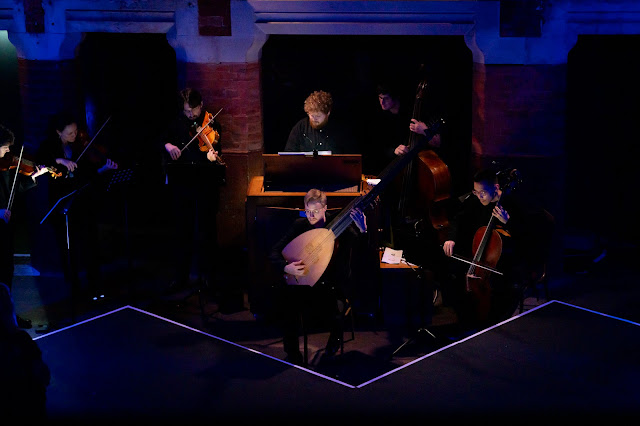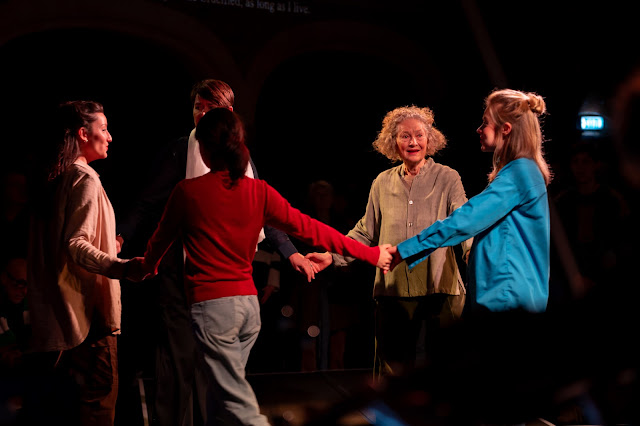 |
| Our Mother - Rowan Pierce, Emma Kirkby, Alexandra Achillea Pouta - Figure at Stone Nest (Photo: Kristina Allen) |
Our Mother: Pergolesi: Stabat Mater with interludes by Alex Mills; Emma Kirkby, Catherine Carby, Rowan Pierce, Alexandra Achillea Pouta, Nadya Pickup, Figure, Frederick Waxman, Sophie Daneman; Stone Nest
Reviewed 23 March 2024
An abstract, immersive staging, concentrating on dramatising the emotional arc of Pergolesi's work interleaved with impressive new interludes from young composer Alex Mills
Historical performance group, Figure, music director Frederick Waxman, has become known for its fascinatingly staged interpretation of classics and recent work has included Mendelssohn's A Midsummer Night's Dream at Opera Holland Park and This is my Body, an immersive staging of Buxtehude's Membra Jesu Nostri [see my review]. For their latest project, Our Mother at Stone Nest (seen 23 March 2024), Figure performed Pergolesi's Stabat Mater with new interludes by composer Alex Mills. The soloists were Dame Emma Kirkby, Catherine Carby, Rowan Pierce, Alexandra Achillea Pouta and Nadya Pickup, with a five-piece instrumental ensemble directed from the organ by Frederick Waxman. The staging was directed by Sophie Daneman with lighting by Chris Burr.
The action took place on a cruciform stage at the centre of Stone Nest's auditorium with audience on three sides, mainly standing with some sitting and looking down from the gallery. Alex Mills' music wrapped around that of Pergolesi, beginning and ending the evening as well as forming interludes between the movement's of the Stabat Mater. Mills' writing was in no way pastiche, this was tonal yet modern and often dramatic, taking threads of Pergolesi and weaving them into radically different material.
 |
| Our Mother - Catherine Carby - Figure at Stone Nest (Photo: Kristina Allen) |
The dramatic presentation used five soloists with a huge age range; Dame Emma Kirkby is in her mid-seventies whilst soprano Nadiya Pickup is 15, and the other three suggested different ages in between. The solos were shared between all five, and some ensemble moments were sung by all singers. The staging was abstract, concentrating on dramatising the emotional arc of Pergolesi's work rather than depicting the events it describes. Costumes might almost have been the singers' own, laid-back and casual, suggesting a group of friends coming together.
The text moves between the narrator observing Mary, commenting on her anguish, and urging us all to petition and address her. Sophie Daneman's staging did not take a particular position about who these people were; were they women witnessing the Crucifixion or where they narrating or re-enacting it. We were left to make our own decision, but each performer's character addressed the emotions as their own, so that Emma Kirkby was most definitely older and experienced with a sense of looking back and observing the others, Catherine Carby was mature and empowered, whilst Rowan Pierce and Alexandra Achillea Pouta were younger, seeming to look up to the others. Nadya Pickup, whose entrance was mid-way through the piece was definitely the voice of youth. What was important was the way the staging highlighted the emotional arc of the work
 |
| Our Mother - Figure at Stone Nest (Photo: Kristina Allen) |
Pergolesi's music for the piece has become iconic because of the striking chromaticism of the opening movement, and throughout the work there is the sense that the opera house is not far way; something that contemporaries complained about. But counter-intuitively, by staging the piece in this abstract way, the performance seemed to move the work away from the 18th century opera house and there was a sense that this staging brought an immediacy and emotional truth to the piece.
I have to confess that when I first learned of this project, I had my doubts but experiencing it in Stone Nest on Saturday, I was completely won over. The performance overall had an intimacy and a directness that really benefits Pergolesi's music, lush romanticism was a long way away. All five performers were impressive, engaging and distinctive, and each brought their own sense of style to the music.
Alex Mills' interludes introduced a feeling of the emotions in a particular movement in the Pergolesi being frozen, the performers often came to a halt, seeming to contemplate in greater depth the horrors that they were seeing.
The seven instrumentalists proved that Pergolesi's work does not need a huge ensemble or a lush string sound. Focus, intent and full of character, the instrumental contribution was an important part of the whole, and the players deftly moved between Pergolesi and Alex Mills, seemingly enjoying the contrasts with Mills distinctly non-period gestures (including slap pizzicatos) alongside period style.
The evening ended with a piece of communal music making! After Our Mother and all the well-deserved applause, we were all invited to join singing Mozart's Ave Verum.
 |
| Our Mother - Alexandra Achillea Pouta, Catherine Carby, Nadya Pickup, Emma Kirkby, Rowan Pierce - Figure at Stone Nest (Photo: Kristina Allen) |
Saturday's performance took place under less than ideal circumstances, as an audience member was taken ill and the performance had to be temporarily suspended, but this hardly disturbed things and everything picked up again impressively.
Never miss out on future posts by following us
The blog is free, but I'd be delighted if you were to show your appreciation by buying me a coffee.
Elsewhere on this blog
- Writing Italian-influenced music in the depths of Northamptonshire: organist William Whitehead on the music of English Baroque composer George Jeffreys - interview
- Two hundred years of music for the horn: Ben Goldscheider in Beethoven, Bowen, Widmann and Watkins - concert review
- Quite an achievement: North London Chorus' ambition rewarded in a performance of Smyth's The Prison that intrigued & engaged - concert review
- From Early Music to contemporary: the Royal Festival Hall organ is 70 and organist James McVinnie is celebrating - interview
- Almost an expressionist nightmare: Janáček's Jenůfa at ENO with Jennifer Davis in the title role - opera review
- Little short of a revelation: Michael Spyres, Les Talens Lyriques & Christophe Rousset explore Wagner's influences with In the Shadows - record review
- Upheaval: cellist Janne Fredens & pianist Søren Rastogi in music by four women composers from the years 1911 to 1918 - record review
- Something astonishing: Olivia Fuchs' new production of Britten's Death in Venice for Welsh National Opera involved a collaboration with circus arts, NoFit State - opera review
- Lumen Christi: I chat to Master of Music, Simon Johnson about his first disc with the choir of Westminster Cathedral - interview
- Szymanowski's rarely performed Harnasie from the LPO, with a visual installation from Wayne McGregor & Ben Cullen Williams - concert review
- Danza Gaya: Simon Callaghan & Hiroaki Takenouchi play with wonderful élan & relish, clearly having a great deal of fun - record review
- Home



,%20William%20Morgan%20(Male%20Chorus)%20(c)%20Richard%20Hubert%20Smith.jpg)


,%20Giorgio%20Vasari,%20Palazzo%20Vecchio,%20Florence.jpg)

.jpg)
%20Benjamin%20Ealovega.jpg)

No comments:
Post a Comment